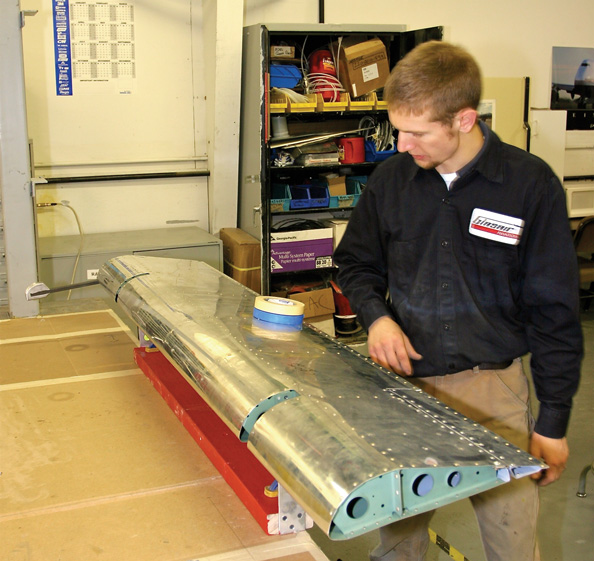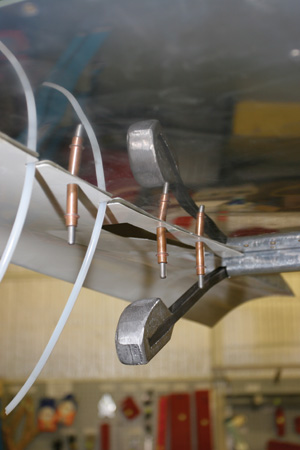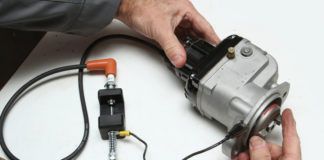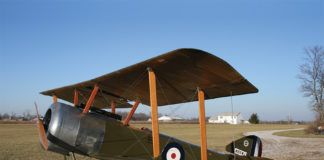
Balancing control surfaces requires care and
Last month we started a look at aeroelasticity. As we saw, airplanes are not perfectly rigid. No matter how stiff the structure is, it does distort under the influence of aerodynamic forces. And structures do not just deflect; they can also vibrate or oscillate.
Flutter is a sustained or increasing oscillation of the airplanes structure that is driven by aerodynamic forces. Sometimes flutter appears as a sustained limit cycle oscillation that maintains a steady amplitude, but does not damp out. Such a flutter is often referred to as buzz. It is undesirable because of the cyclic loads it puts on the airframe, which can cause failures due to fatigue or working fasteners loose. In general, having a sustained aerodynamically driven oscillation in the airframe structure is considered unacceptable for safe operation of the airplane.
In more severe cases, the flutter oscillation does not reach a limiting steady-state amplitude, but grows rapidly once the oscillation begins. This situation is extremely dangerous, because if the building flutter is not stopped quickly, it will cause catastrophic structural failure of the airframe.
Mechanism
A structure has multiple degrees of freedom, which lead to multiple modes of deflection/vibration. For example, on a cantilever wing the first two structural modes are wing bending, where the wing bends up or down like a diving board, and wing torsion, where the wingtip twists relative to the root. Each structural mode has a natural frequency at which it vibrates when it is excited by a force. The natural frequency is determined by the stiffness of the structure and its mass and inertia. In some modes, where the aerodynamic force that arises from deflection acts like a centering spring (aileron deflection, for example), the frequency is also a function of airspeed.
For flutter to occur, two conditions must be met. First, two modes must have the same natural frequency. When the natural frequency of two modes is the same, the motions of the modes couple, allowing one mode to directly affect the other. The second condition for flutter is that deflection in one mode causes forces that drive a deflection in the second mode. For example, wing twist changes the lift of the outer portion of the wing, which in turn changes the bending moment on the wing. Accordingly, a change in wing twist (one mode) causes a change in wing bending (other mode). If the natural frequencies of the first wing-bending mode and the first wing torsional mode are the same, there is a potential for flutter.
Other factors affecting the onset of flutter are the amount of damping in the system and the magnitude of the driving aerodynamic forces. Damping absorbs energy while opposing the motion of the structure. An example of this is friction in a control-surface hinge or linkage. When the surface moves, the friction opposes the motion and absorbs some of the energy trying to make the surface move. The faster the surface moves, the more energy the friction dissipates. Because it tends to reduce the motion of the structure, damping delays flutter onset.
The aerodynamic forces that drive the deflections increase as a function of the dynamic pressure, which is proportional to airspeed squared. The higher the airspeed, the higher the aerodynamic force, and the more energy the aerodynamic forces can provide to drive the structural oscillation.

Mass-balance weights can help increase flutter margins.
Flutter Onset
As airspeed increases, two things happen: The magnitude of the aerodynamic forces on the airplane increase, and the natural frequency of some of the deflection modes changes, typically increasing with increasing airspeed. If the natural frequency of the right two modes come together at an airspeed that is high enough for the aerodynamic forces to overpower the damping in the system, the conditions for flutter exist.
In perfectly smooth air, an airplane flying above this critical flutter speed may not start to flutter immediately. The flutter can be triggered by a gust or a control input that produces a force that excites one of the critical structural modes. Once started, the flutter will continue or build in magnitude until it is stopped either by a physical constraint of the structure, a sufficient reduction in airspeed or, unfortunately, a failure of the structure. The fact that the airplane can get to an airspeed significantly above the minimum speed for initial flutter onset is particularly dangerous because when the flutter starts, the airplane will be flying fast enough for the flutter to be violent and sometimes destructively divergent. It will also be difficult to slow the airplane enough to stop the flutter in time to avoid structural failure.
Aileron Flutter
One of the more troublesome types of flutter encountered in general aviation airplanes is aileron flutter. Aileron flutter first appeared when designers learned how to make early airplanes, usually monoplanes, faster than the original open box-kite-style machines. Many racers of the 1920s and 1930s (including the GeeBee Z and the Supermarine S4) succumbed to aileron flutter, which was a mysterious and little understood phenomenon at the time.
If an aileron is deflected and then released, aerodynamic moment will drive it back toward the trail position. Because the aileron has some inertia, it will overshoot and then be driven the other way, back toward trail. Usually, this motion is highly damped, and the aileron will stop moving quickly. The oscillation, even when it is damped, has a natural frequency and amplitude that will change with airspeed.
The other structural mode that plays a part is the first wing-bending mode. In this mode the wings bend up or down symmetrically. If the wing is excited by a gust, or a change in lift due to a maneuver, the wing will vibrate up and down like a diving board.
At an airspeed where the natural frequency of the ailerons motion around the hinge is the same as that of the first wing-bending mode there is the potential for flutter.
The other key player in aileron flutter is the mass properties of the aileron. An upward motion of the wingtip will accelerate the aileron upward along with the wing. If the center of gravity of the aileron is behind the hinge line, the aileron will lag and deflect down. This deflection produces more lift at the tip, which further accelerates the wing upward. The aileron continues to lag and drives the wing upward until the stiffness of the wing slows and then stops the upward motion. This deceleration will cause the aileron to flap upward, producing aerodynamic downforce that drives the wing back down at the same time as the wings natural spring action is also accelerating the tip down. Once again, the aileron lags, producing force that drives the wingtip down until the wings stiffness slows the motion and starts the tip accelerating back up. The aileron lags downward, and the cycle repeats. If the natural frequencies of the wing and aileron are significantly different, the aileron will return to trail quickly after the initial bump, and the system will remain stable.
If the frequencies are the same, then the aileron motion will couple with the wing motion so that the aileron produces oscillating forces that are in phase with the wing bending, and amplify the motion. The vibration will grow quickly until the damping in the system limits its amplitude to a steady-state buzz, or until the forces get so large that they destroy the structure. This destructive divergence can happen quickly, with only a few seconds between the beginning of the flutter and catastrophic failure.
Prevention
To prevent aileron flutter from happening, we need to make sure that the coupling between the wing-bending mode and the aileron oscillation mode does not happen. One way to do this is to alter the mass properties of the aileron so that the vertical accelerations of the aileron caused by wing bending do not result in an aileron deflection. This is the function of mass balances. By attaching a mass that is forward of the hinge line to the aileron, we can move the center of gravity of the aileron to the hinge line. If the aileron CG is at the hinge line, the aileron will not deflect as a result of vertical acceleration. If the aileron does not deflect, it does not produce lift forces in phase with the bending. This in-phase force from the aileron is what drives the flutter. If it is eliminated, so is the potential for flutter.
It is important to note here that for mass balancing to be effective, the CG of the control surface must be at or ahead of the hinge line. Partial mass balancing that moves the control surface CG forward but not all the way to the hinge line can be ineffective, and in some cases actually cause flutter by changing the natural frequency of the aileron without eliminating the lagging deflection from vertical accelerations.
A second approach to preventing aileron flutter is to have the control system constrain the aileron so it cannot make uncommanded deflections relative to the wing. If successful, this approach essentially makes the aileron a rigidly connected part of the wing and eliminates the acceleration-induced aileron deflections that drive the flutter.
This approach is widely used on high-performance airplanes with powered control systems. The aileron is controlled by several hydraulic or electric actuators that are strong enough to act as a rigid link between the aileron and the rest of the wing. It is critical, on such a system, that the linkages be very tight, with no free play that allows the aileron to move independently of the actuator.
Depending on the control cables of a cable-actuated manual system to constrain the aileron enough to prevent flutter is very risky. The tension in the control cables must be high to keep things safe, and the system is not tolerant of any stretching or improper rigging of the aileron control cables. The cables can stretch over time and loosen, or change length a bit due to changes in temperature. If this happens, the airplane can become flutter-prone with little or no warning as the result of a subtle change that is difficult or impossible to detect during a preflight inspection.
Depending on the control cables to prevent flutter makes the cables, in effect, flight-critical structural components of the airplane. It is common practice to require that a manually controlled airplane be able to survive the disconnect or failure of a single control and remain sufficiently controllable for the pilot to land safely. If a control disconnect leads to aileron flutter, this requirement was obviously not met. For airplanes with manually controlled ailerons, mass balancing is the preferred, and much safer, way of preventing aileron flutter.

![]()
Barnaby Wainfan is a principal aerodynamics engineer for Northrop Grummans Advanced Design organization. A private pilot with single engine and glider ratings, Barnaby has been involved in the design of unconventional airplanes including canards, joined wings, flying wings and some too strange to fall into any known category.













